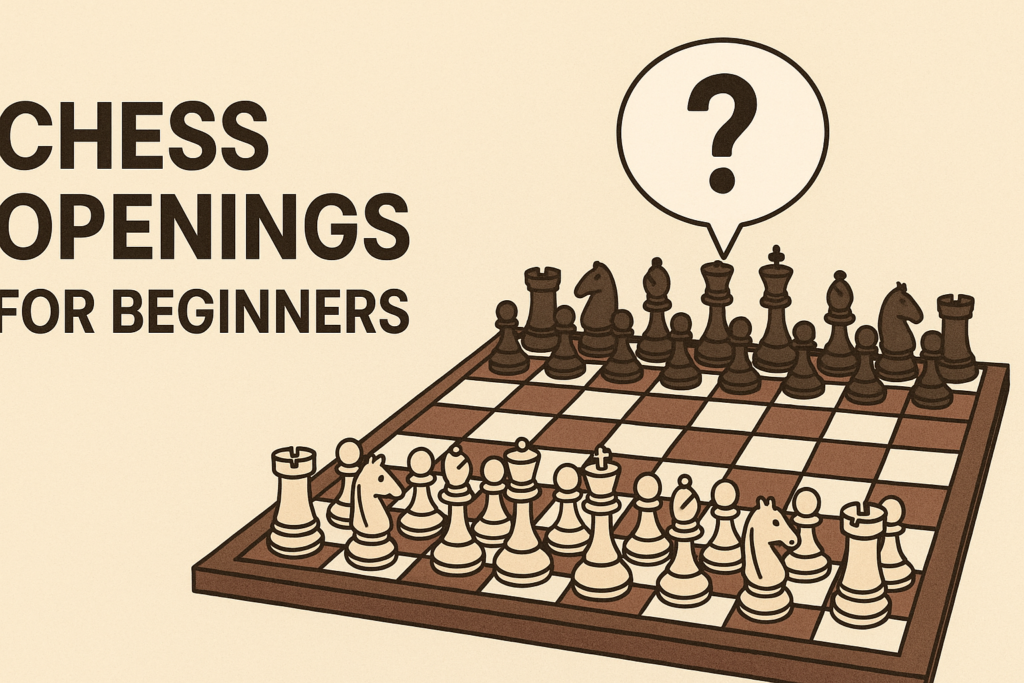Explore the four key opening choices in chess and how to play aggressively or solidly as White or Black, with examples and guidance for all skill levels.
Introduction: The Four Essential Choices
Before sitting down at a chessboard, every player faces four foundational decisions:
- Whether to open as White with 1.e4, 1.d4, or a Reti/English system, and what to play against semi-open or Indian defenses.
- How to respond to 1.e4 as Black.
- How to respond to 1.d4 as Black.
- How to respond to the Reti/English systems as Black.
These choices often reflect personal preferences, whether one enjoys attacking or prefers solid structures, and whether open or closed positions feel more comfortable. It’s also important to consider how each choice fits within the overall repertoire. For instance, choosing the Dutch or English defenses after 1.d4 e6 implies a willingness to play the French Defense. Similarly, players who enjoy the Slav Defense with …c6 may find the Caro-Kann (also employing …c6) a natural complement.
Among opening moves, 1.e4 is the most common, and widely regarded as the strongest, with 1.d4 also considered an excellent choice. However, almost every legal first move has been explored and championed at some point, and nearly every legal Black response has been tried against both 1.e4 and 1.d4.
A visual opening map is included below. Memorizing this map still only scratches the surface: the Oxford Companion to Chess lists over a thousand named openings, defenses, and variations. The map is not meant to encourage aimless exploration, but to serve as a reference when encountering unfamiliar lines. Every viable opening should have a plan, if it doesn’t, it’s likely not a good opening.
Numerous openings, both mainstream and fringe, exist beyond the map. For example, modern literature continues to highlight established systems like the Torre Attack (1.d4 Nf6 2.Nf3 and 3.Bg5), while more obscure lines such as the Vulture (1.d4 Nf6 2.c4 c5 3.d5 Ne4 see diagram below) remain on the periphery.
As GM William Lombardy once stated:
“All openings offer good winning chances in amateur play.”
There was once a player known informally as H.4.Stewart due to his consistent use of 1.h4 as an opening (also known as Kadas Opening or Desprez Opening). This unconventional approach likely spared him hours of studying deeply analyzed Sicilian Dragon lines. In such cases, the best advice is to remain calm and play good chess: develop pieces, control the center, and stay alert, regardless of how unorthodox the opponent’s first move may be.
See more: Chess Strategy for Beginners: How to Think Like a Grandmaster
Coping with the Diversity of Openings
The sheer variety of openings can be overwhelming. A useful perspective comes from Richard Reti, who famously remarked:
“A knowledge of tactics is the foundation of positional play. This is a rule which has stood its test in chess history and one which we cannot impress forcibly enough upon the young chess player. A beginner should avoid Queen’s Gambit and French Defence and play open games instead! While he may not win as many games at first, he will in the long run be amply compensated by acquiring a thorough knowledge of the game.”
A chess player’s development often mirrors the evolution of chess history itself. In the era of MacDonnell and LaBourdonnais (and even Steinitz and Chigorin), dynamic gambits like the Evans were popular. Later, the Ruy Lopez took center stage in the Lasker-Steinitz era. Capablanca and Alekhine mainly contested the Queen’s Gambit Declined, whereas in earlier times, the Queen’s Gambit Accepted was more prevalent.
During Euwe’s matches, Semi-Open defenses such as the French, as well as Indian systems like the Dutch, Grunfeld, and Nimzo-Indian, gained prominence at the championship level. Botvinnik’s era brought the Caro-Kann, King’s Indian, and flank openings (Reti and English) into regular use, while Karpov and Kasparov explored virtually the entire spectrum of opening theory.
From this history, one can outline a developmental hierarchy:
- Open games and gambits: 1.e4 e5; Queen’s Gambit Accepted
- Classical mainlines: Ruy Lopez; Queen’s Gambit Declined
- Semi-open and Indian defenses: French, Dutch (see diagram below), Grunfeld, Queen’s and Nimzo-Indian
- Flank systems and hypermodern ideas: Reti, English, King’s Indian
Strategically simpler openings at the top of this list provide a solid foundation. Only after mastering these should one venture into more complex terrain. A shift to deeper or more obscure systems should ideally stem from boredom or the realization that familiar lines are too well-known among regular opponents, not from fear or dissatisfaction. Consider Bobby Fischer’s career-long preference for 1.e4, or Karpov’s use of the Giuoco Piano against Kortchnoi.
Read more: Beginner Chess Puzzles: Cracking the Code One Move at a Time
Playing Aggressively or Solidly as White and Black
Beyond the four basic choices, one crucial decision precedes them: whether to adopt an aggressive or solid playing style. Reti advised favoring open games, which encourage an aggressive style and provide opportunities to develop tactical awareness, a skill fundamental to understanding positional play. For players who have already undergone this tactical apprenticeship, more solid and strategic systems become viable options.
Statistical analysis from opening databases shows how different openings influence game outcomes. For example:
- Italian Game: 41% White wins, 26% draws, 33% White losses
- English Opening: 37% White wins, 36% draws, 27% White losses
- King’s Gambit: 47% White wins, 15% draws, 38% White losses
Each line totals approximately 54% score for White, but stylistic differences are significant. Even within the Giuoco Piano, playing d2-d4 instead of d2-d3 reduces draw rates by 10%. Thus, opening choices meaningfully shape the character of a game, even though the opponent ultimately shares in the decision.
Summary of Opening Choices
White with 1.e4
- Aggressive Options:
- Against 1…e5: Danish Gambit, Giuoco Piano with d2-d4 / Max Lange, King’s Gambit, Vienna Gambit, Bishop’s Opening (Urusoff Gambit), Ruy Lopez with early d4
- Against semi-open defenses: Early d2-d4, advance variations, Blackmar-Diemer Gambit, Morra Gambit
- Solid Options:
- Against 1…e5: Centre Game, Bishop’s Opening / Giuoco Piano with d2-d3, Vienna Game, Ruy Lopez with delayed or no d4
- Against semi-open defenses: Advance variations, King’s Indian Attack
White with 1.d4
- Aggressive Options:
- Against 1…d5: Blackmar-Diemer Gambit, Queen’s Gambit with queenside castling
- Against Indian defenses: Kingside pawn storms (e.g., Saemisch vs. King’s Indian)
- Solid Options:
- Against 1…d5: Queen’s Gambit Declined with O-O, Queen’s Pawn games without c2-c4
- Against Indian defenses: Queenside pawn storms (e.g., Classical King’s Indian)
White with the Reti/English
- Aggressive Options: King’s Indian Attack, Botvinnik System of the English
- Solid Options: Queenside pawn storms, b2-b3 systems
Black against 1.e4
- Aggressive Options: Sicilian Defense, Alekhine’s Defense, Pirc/Modern
- Solid Options: Petroff Defense, French, Caro-Kann, Modern with …c6
Black against 1.d4
- Aggressive Options: Tarrasch Defense, Budapest Gambit, Benko/Benoni, King’s Indian, Grunfeld
- Solid Options: Slav Defense, Queen’s Gambit Declined (e.g., Tartakower), Nimzo-Indian, Queen’s Indian
Black against the Reti/English
- Aggressive Options: Reversed Sicilian, Dutch systems, King’s Indian
- Solid Options: Slav Defense, London System
Those unfamiliar with any of these openings should consult additional resources, as this overview alone does not provide sufficient detail for practical play.

I’m Xuan Binh, the founder of Attacking Chess, and the Deputy Head of Communications at the Vietnam Chess Federation (VCF). My chess.com and lichess rating is above 2300. Send me a challenge or message via Lichess. Follow me on Twitter (X) or Facebook.







2 thoughts on “Chess Openings For Beginners: 4 Questions You Need to Reply”
Comments are closed.